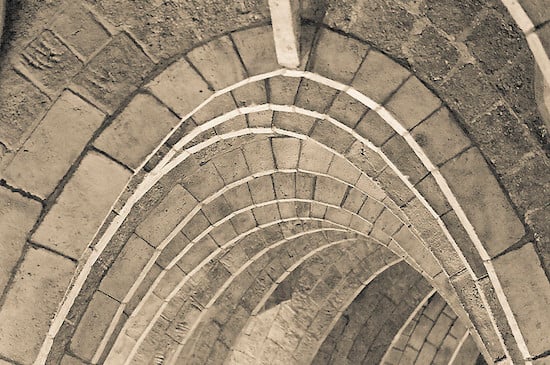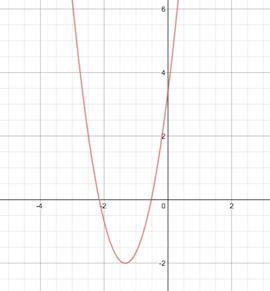How To Find Vertex From Factored Form
In one case you have the quadratic formula and the nuts of quadratic equations down cold, it's time for the next level of your human relationship with parabolas: learning about their vertex grade. Read on to learn more than about the parabola vertex form and how to convert a quadratic equation from standard form to vertex course. feature image credit: SBA73/Flickr The vertex form of an equation is an alternate manner of writing out the equation of a parabola. Normally, you'll see a quadratic equation written as $ax^two+bx+c$, which, when graphed, will be a parabola. From this form, it'southward piece of cake enough to find the roots of the equation (where the parabola hits the $x$-axis) by setting the equation equal to zero (or using the quadratic formula). If y'all need to find the vertex of a parabola, however, the standard quadratic course is much less helpful. Instead, yous'll want to catechumen your quadratic equation into vertex form. While the standard quadratic form is $ax^2+bx+c=y$, the vertex course of a quadratic equation is $\bi y=\bi a(\bi x-\bi h)^ii+ \bi k$. In both forms, $y$ is the $y$-coordinate, $x$ is the $x$-coordinate, and $a$ is the constant that tells you whether the parabola is facing upwards ($+a$) or down ($-a$). (I think most it every bit if the parabola was a bowl of absurdity; if at that place'due south a $+a$, I can add applesauce to the bowl; if there'south a $-a$, I tin milk shake the applesauce out of the basin.) The deviation between a parabola's standard class and vertex form is that the vertex form of the equation also gives you the parabola's vertex: $(h,k)$. For example, take a look at this fine parabola, $y=3(x+four/iii)^2-2$: Based on the graph, the parabola's vertex looks to be something similar (-ane.5,-ii), but it's hard to tell exactly where the vertex is from simply the graph alone. Fortunately, based on the equation $y=3(x+iv/iii)^2-2$, nosotros know the vertex of this parabola is $(-4/3,-2)$. Why is the vertex $(-4/3,-2)$ and not $(4/3,-2)$ (other than the graph, which makes it clear both the $x$- and $y$-coordinates of the vertex are negative)? Remember: in the vertex form equation, $h$ is subtracted and $k$ is added. If you have a negative $h$ or a negative $k$, you'll need to brand certain that yous subtract the negative $h$ and add the negative $k$. In this case, this means: $y=iii(x+4/3)^2-2=three(10-(-iv/three))^2+(-2)$ and and then the vertex is $(-4/3,-2)$. You should always double-check your positive and negative signs when writing out a parabola in vertex form, especially if the vertex does not take positive $x$ and $y$ values (or for you quadrant-heads out at that place, if it's non in quadrant I). This is similar to the cheque you'd do if you lot were solving the quadratic formula ($10={-b±√{b^2-4ac}}/{2a}$) and needed to make sure you kept your positive and negatives direct for your $a$s, $b$s, and $c$southward. Beneath is a tabular array with further examples of a few other parabola vertex form equations, along with their vertices. Note in particular the difference in the $(x-h)^2$ role of the parabola vertex class equation when the $10$ coordinate of the vertex is negative. Parabola Vertex Form Vertex Coordinates $y=5(x-4)^ii+17$ $(iv,17)$ $y=2/3(x-8)^2-i/3$ $(eight,-ane/3)$ $y=144(x+ane/2)^2-ii$ $(-1/2,-2)$ $y=ane.8(x+ii.4)^2+two.four$ $(-2.4,two.4)$ Most of the time when you lot're asked to convert quadratic equations between different forms, you'll be going from standard form ($ax^ii+bx+c$) to vertex form ($a(x-h)^two+k$). The process of converting your equation from standard quadratic to vertex class involves doing a set of steps called completing the square. (For more than almost completing the square, be sure to read this article.) Let's walk through an example of converting an equation from standard grade to vertex form. Nosotros'll start with the equation $y=7x^two+42x-3/14$. The commencement thing you'll want to do is move the constant, or the term without an $x$ or $x^two$ next to it. In this case, our abiding is $-three/14$. (We know it'due south negative $three/14$ because the standard quadratic equation is $ax^two+bx+c$, non $ax^2+bx-c$.) First, we'll accept that $-3/fourteen$ and move it over to the left side of the equation: $y+3/14=7x^2+42x$ The next step is to factor out the 7 (the $a$ value in the equation) from the right side, like so: $y+3/xiv=7(x^2+6x)$ Bang-up! This equation is looking much more like vertex form, $y=a(ten-h)^2+grand$. At this point, you might be thinking, "All I need to do now is to move the $iii/fourteen$ back over to the right side of the equation, right?" Alas, non then fast. If you take a await at part of the equation within of the parentheses, yous'll notice a problem: it's not in the form of $(ten-h)^2$. There are besides many $x$s! Then we're not quite washed withal. What nosotros need to exercise at present is the hardest role—completing the square. Let's have a closer look at the $x^2+6x$ office of the equation. In order to gene $(ten^2+6x)$ into something resembling $(x-h)^ii$, we're going to need to add a constant to the inside of the parentheses—and nosotros're going to need to recollect to add together that constant to the other side of the equation too (since the equation needs to stay counterbalanced). To ready this up (and brand sure we don't forget to add the constant to the other side of the equation), we're going to create a blank space where the constant volition continue either side of the equation: $y+3/14+7($ $)=vii(10^two+6x+$ $)$ Annotation that on the left side of equation, nosotros made sure to include our $a$ value, seven, in front of the infinite where our constant will go; this is because nosotros're not just adding the constant to the correct side of the equation, only we're multiplying the abiding past any is on the outside of the parentheses. (If your $a$ value is 1, you lot don't need to worry most this.) The next step is to complete the square. In this case, the square you're completing is the equation inside of the parentheses—by calculation a constant, you're turning it into an equation that tin be written every bit a square. To calculate that new constant, take the value adjacent to $x$ (6, in this case), divide it past 2, and square information technology. $(6/two)^2=(3)^two=9$. The constant is nine. The reason we halve the half dozen and square it is that we know that in an equation in the form $(x+p)(10+p)$ (which is what nosotros're trying to get to), $px+px=6x$, and so $p=6/2$; to go the abiding $p^2$, we thus take to accept $6/two$ (our $p$) and square it. Now, supervene upon the blank space on either side of our equation with the abiding 9: $y+iii/14+7(9)=seven(x^ii+6x+9)$ $y+{3/14}+63=seven(10^2+6x+ix)$ $y+{three/14}+{882/14}=7(x^2+6x+9)$ $y+{885/xiv}=7(10^two+6x+ix)$ Next, factor the equation inside of the parentheses. Considering we completed the square, y'all volition be able to factor it as $(x+{\some \number})^ii$. $y+{885/xiv}=7(ten+iii)^2$ Last step: move the non-$y$ value from the left side of the equation back over to the right side: $y=7(x+three)^2-{885/14}$ Congratulations! You lot've successfully converted your equation from standard quadratic to vertex class. At present, most bug won't only ask yous to convert your equations from standard form to vertex form; they'll want you to actually requite the coordinates of the vertex of the parabola. To avoid getting tricked by sign changes, allow's write out the general vertex form equation directly above the vertex course equation nosotros just calculated: $y=a(x-h)^ii+g$ $y=7(x+3)^2-{885/14}$ So we can hands find $h$ and $k$: $-h=3$ $h=-3$ $+k=-{885/14}$ The vertex of this parabola is at coordinates $(-3,-{885/14})$. Whew, that was a lot of shuffling numbers around! Fortunately, converting equations in the other management (from vertex to standard form) is a lot simpler. Converting equations from their vertex form to the regular quadratic form is a much more straightforward process: all yous need to exercise is multiply out the vertex form. Permit's accept our example equation from earlier, $y=iii(x+four/3)^2-two$. To plow this into standard form, nosotros just expand out the right side of the equation: $$y=3(ten+4/3)^two-2$$ $$y=iii(x+4/3)(x+4/3)-2$$ $$y=3(x^2+{viii/3}ten+16/ix)-ii$$ $$y=3x^two+8x+{16/three}-2$$ $$y=3x^2+8x+{16/3}-{6/three}$$ $$y=3x^two+8x+ten/3$$ Tada! Y'all've successfully converted $y=3(x+4/3)^2-ii$ to its $ax^ii+bx+c$ form. To wrap upwardly this exploration of vertex form, we have four example issues and explanations. See if you tin solve the bug yourself earlier reading through the explanations! #1: What is the vertex form of the quadratic equation $x^2+ 2.6x+1.ii$? #two: Convert the equation $7y=91x^2-112$ into vertex course. What is the vertex? #iii: Given the equation $y=2(10-3/ii)^ii-ix$, what are the $x$-coordinates of where this equation intersects with the $x$-axis? #4: Observe the vertex of the parabola $y=({1/ix}10-vi)(x+4)$. #1: What is the vertex form of the quadratic equation ${\bi x^2}+ two.6\bi x+1.two$? Get-go past separating out the non-$x$ variable onto the other side of the equation: $y-i.2=x^ii+two.6x$ Since our $a$ (as in $ax^2+bx+c$) in the original equation is equal to 1, we don't need to factor information technology out of the right side here (although if y'all desire, you tin write $y-i.2=one(x^2+ii.6x)$). Next, divide the $x$ coefficient (ii.6) by two and square information technology, then add the resulting number to both sides of the equation: $(two.6/2)^two=(ane.iii)^2=1.69$ $y-1.2+1(one.69)=1(x^two+two.6x+1.69)$ Cistron the right side of the equation inside the parentheses: $y-ane.2+1.69=(ten+1.iii)^two$ Finally, combine the constants on the left side of the equation, and so move them over to the right side. $y-1.2+1.69=(x+ane.3)^2$ $y+0.49=(x+1.iii)^2$ Our answer is $y=(x+one.three)^2-0.49$. #2: Convert the equation $7\bi y=91\bi x^2-112$ into vertex course. What is the vertex? When converting an equation into vertex form, you want the $y$ accept a coefficient of 1, so the get-go affair we're going to do is divide both sides of this equation past 7: $7y= 91x^2-112$ ${7y}/7= {91x^2}/7-112/7$ $y=13x^two-xvi$ Next, bring the abiding over to the left side of the equation: $y+16=13x^2$ Factor out the coefficient of the $x^2$ number (the $a$) from the right side of the equation $y+16=13(x^two)$ Now, usually y'all'd have to complete the square on the right side of the equation inside of the parentheses. However, $x^2$ is already a foursquare, and so yous don't need to do anything besides moving the constant from the left side of the equation back to the right side: $y=13(ten^2)-16$. Now to find the vertex: $y=a(x-h)^2+k$ $y=13(10^2)-xvi$ $-h=0$, so $h=0$ $+m=-16$, so $k=-16$ The vertex of the parabola is at $(0, -sixteen)$. #3: Given the equation $\bi y=2(\bi x-3/two)^2-9$, what is(are) the $\bi x$-coordinate(s) of where this equation intersects with the $\bi x$-axis? Considering the question is asking y'all to discover the $ten$-intercept(s) of the equation, the start pace is to set $y=0$. $y=0=two(ten-3/2)^2-nine$. Now, there are a couple of ways to get from here. The sneaky way is to use the fact that there's already a square written into the vertex form equation to our advantage. Start, nosotros'll motility the constant over to the left side of the equation: $0=2(ten-3/2)^2-nine$ $9=two(x-3/two)^2$ Adjacent, we'll divide both sides of the equation by 2: $9/2=(x-3/ii)^ii$ Now, the sneaky function. Accept the foursquare root of both sides of the equation: $√(ix/2)=√{(x-3/two)^2}$ $±iii/{√2}=(x-3/2)$ $±{{iii√2}/2}=ten-{3/2}$ ${3√two}/ii=x-{iii/two}$ and ${-3√2}/2=x-{three/ii}$ $x=3/2+{3√ii}/2$ and $x=3/2-{iii√2}/2$ Alternatively, you can find the roots of the equation past offset converting the equation from vertex form back to the standard quadratic equation form, then using the quadratic formula to solve it. First, multiply out the right side of the equation: $0=2(10-{three/ii})^ii-9$ $0=2(x^2-{6/2}x+{9/4})-9$ $0=2x^2-6x+{9/2}-9$ Then, combine similar terms: $0=2x^two-6x-ix/two$ At this point you can either choose to try and work out the factoring yourself past trial and mistake or plug the equation into the quadratic formula. If I see a coefficient side by side to the $ten^ii$, I ordinarily default to the quadratic formula, rather than trying to keep everything straight in my head, and then let's go through that hither. Remembering that $2x^2-6x-nine/2$ is in the course of $ax^ii+bx+c$: $x={-b±√{b^two-4ac}}/{2a}$ $ten={-(-six)±√{(-6)^2-four(2)(-9/two)}}/{2(2)}$ $x={6±√{36-4(-ix)}}/iv$ $x={half dozen±√{36+36}}/4$ $ten={6±√{72}}/4$ $x={six+6√2}/4$ and $x={-six-6√ii}/4$ $x=iii/two+{3√2}/2$ and $ten=3/ii-{three√2}/two$ #four: Find the vertex of the parabola $\bi y=({i/9}\bi ten-half dozen)(\bi x+4)$. The first step is to multiply out $y=({1/9}x-half-dozen)(x+4)$ so that the abiding is separate from the $x$ and $x^2$ terms. $y={1/9}{x^2}+(-6+{4/9})ten-24$ Next, movement the constant over to the left side of the equation. $y+24={1/ix}{ten^2}-{50/9}x$ Factor out the $a$ value from the right side of the equation: $y+24={i/9}(x^2-50x)$ Create a space on each side of the equation where y'all'll be adding the abiding to consummate the square: $y+24+one/9($ $ )={1/9}(x^2-50x+$ $)$ Calculate the constant by dividing the coefficient of the $x$ term in half, so squaring it: $(-fifty/2)^2=(-25)^ii=625$ Insert the calculated constant back into the equation on both sides to complete the square: $y+24+{1/ix}(625)={1/9}(x^2-50x+625)$ Combine like terms on the left side of the equation and factor the right side of the equation in parentheses: $y+{216/9}+{625/9}={1/9}(ten-25)^2$ $y+{841/nine}={1/9}(x-25)^two$ Bring the abiding on the left side of the equation dorsum over to the right side: $y={1/9}(10-25)^ii-{841/ix}$ The equation is in vertex grade, woohoo! Now, to observe the vertex of the parabola: $y=a(10-h)^ii+k$ $y={one/9}(x-25)^2-{841/9}$ $-h=-25$ so $h=25$ $+k=-{841/9}≈-93.4$ (rounded) The vertex of the parabola is at $(25,-93.4)$. Can't get enough of completing the square? Review how to complete the square and when else you might desire to apply information technology in this article. While graphing parabolas is fun to do by manus, a graphing calculator is all the same a handy tool to have. Read our commodity on the best graphing calculators (both physical and online) hither. In the midst of coordinate geometry and factoring quadratics? Our list of perfect squares and graph quadrant definitions are hither for you. Studying for SAT/Human action Math? Our manufactures on the disquisitional math formulas you need to know for Sat Math and Human action Math are indispensable.
Why Is Vertex Form Useful? An Overview
What Is Vertex Form?

How to Convert From Standard Quadratic Form to Vertex Class

How to Catechumen From Vertex Grade to Standard Course

Parabola Vertex Form Practise: Sample Questions

Parabola Vertex Form Practice: Solutions

What's Next?

About the Writer
Laura graduated magna cum laude from Wellesley College with a BA in Music and Psychology, and earned a Primary's degree in Composition from the Longy School of Music of Bard College. She scored 99 percentile scores on the SAT and GRE and loves advising students on how to excel in loftier school.
Source: https://blog.prepscholar.com/vertex-form-parabola
Posted by: faydoely1954.blogspot.com


0 Response to "How To Find Vertex From Factored Form"
Post a Comment